Last Updated on September 6, 2023
Bathroom nice-to-haves can quickly turn into nightmare necessities when shower door seals become discolored and dull. The reality is, whether it be from age or improper cleaning products, this issue will eventually pop up. So arm yourself with the knowledge of just how to clean discolored shower door seals properly.
Keeping your shower door seals looking brand new doesn’t have to be a time-consuming ordeal. With the help of natural ingredients such as baking soda or borax, you can easily keep those pesky discolorations at bay. But it’s hard to clean discolored seals if you don’t have the right knowledge.
So here’s a comprehensive guide to help you restore your shower door seals back to crystal clear again.
How to Clean Discoloured Shower Door Seals: Steps to Follow

Cleaning discolored shower door seals can seem like a tedious task. But, with a few simple steps and some cleaning supplies, you’ll be able to get your seals looking like new again.
Here are the steps you need to follow:
Gather materials needed:
- Soft sponge or cloth
- Baking soda
- Vinegar
- Soft scrub brush (optional)
- Toothbrush
Step 1: Prepare the Work Area
Before starting the cleaning process, one should ensure that the work area is properly prepared. This means that all objects, such as shampoo bottles and sponges, should be removed from the shower door seal.
It is also vital that the area around the seal be free of dirt and debris that could potentially cause scratches on the sealing surface during cleaning. The seal should also be wiped with a damp cloth to remove any visible dust or dirt before cleaning.
Step 2: Apply Borax Or Baking Soda
Borax powder or baking soda effectively cleans discolored shower door seals without being too harsh for the seal material. To create the cleaning solution, combine one cup of borax powder or baking soda with two tablespoons of liquid dish soap, like castile soap or dishwashing liquid, in two cups of hot water.
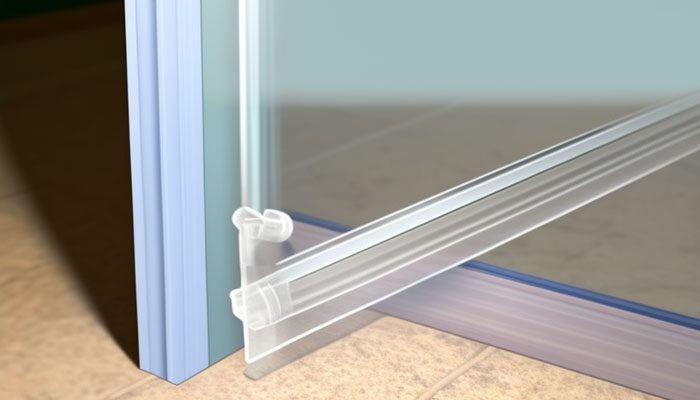
Stir until dissolved, then use a sponge or rag to apply it evenly over the entire surface of the seal. Allow it to sit for 10 to 15 minutes before rinsing off with warm water.
Step 3: Use Vinegar Spray
To further assist in removing discoloration from shower seals, vinegar spray can be used after applying Borax or baking soda. Its natural acidity helps break down soap scum and build up from hard water minerals such as calcium deposits.
To create a vinegar spray solution, combine one teaspoon of dishwashing liquid or castile soap with white vinegar and water in a spray bottle before spraying onto the seal gently but evenly. Allow this mixture to sit for 15 to 20 minutes before wiping it away.
This will help lift off any stubborn areas more easily while also killing germs at the same time. Don’t leave the residue too long afterward, as vinegar can leave an unpleasant smell behind.
Step 4: Rinse Thoroughly With Warm Water
Once you’ve finished cleaning your shower door seals using either borax/baking soda or vinegar spray, it’s time to rinse them off thoroughly with warm water using a rag or towel. This will help ensure that all residue has been removed from the seal material and leave them looking like new again.
Using a soft cloth, you’ll be able to dry them off after rinsing off all excess moisture, giving them a beautiful shine.
Reasons Why Shower Door Seals Become Discolored
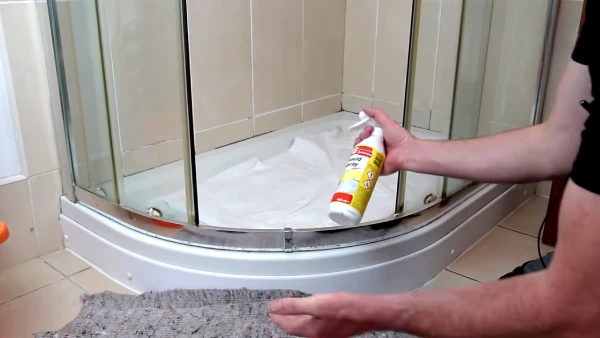
As we know, seals can become discolored over time due to their exposure to various environmental factors. To prevent this discoloration, it is important to understand what causes them.
Among the most common reasons are:
Poor Quality Materials
Shower door seals are typically made of rubber, plastic, and other materials that are not designed to withstand long-term exposure to moisture, heat, cleaning chemicals, and sunlight. Low-quality seal materials may become discolored from exposure to these elements over time if they are not carefully maintained.
The seal material can degrade, leading to changes in color, cracking, and crumbling of the material. Poor-quality seals may also resist cleaning efforts due to their low durability. Also, poorly manufactured shower door seals may also contain impurities that can cause discoloration or fade over time.
Use of Harsh Cleaning Products
Using harsh cleaners on shower door seals can lead to discoloration or staining over time due to the corrosive properties of many household cleaners. Bleach-based products or abrasive cleaners can be especially damaging if left on the surface for too long or applied excessively.
The chemicals in these cleaners can react with the seal material, making it deteriorate and discolored. Use mild soaps when cleaning shower door seals and avoid using harsher chemical-based products whenever possible.

Improper Maintenance Practices
By neglecting regular maintenance of your shower door seals, you can cause them to discolor more quickly than normal due to dirt and grime building up on their surface. Unless you clean your shower doors regularly with mild soap and water solutions or use lubricants designed for shower door seals, dirt can build up on the surfaces.
This can cause discoloration and clogs, which can cause more damage over time if they’re not taken care of properly.
Sunlight Exposure
Sunlight exposure can cause rubber seals to discolor over time due to the UV radiation from the sun, which breaks down and degrades the rubber. If the seal is continuously exposed to direct sunlight for prolonged periods of time, or in areas with extreme temperatures, this process can be accelerated.
Aside from that, certain pigments used in rubber seals may fade faster when exposed to sunlight and heat, leaving an uneven coloration.
Pollution and Contaminants Water Supply
Chemicals found in water or air contaminants, such as chlorine and other cleaning agents, can cause rubber seals around shower doors to become discolored. Over time these chemicals can bond with the rubber in the seal, causing it to break down and lose its original color.
To avoid this, it’s important to ensure any chemical cleaners or disinfectants used are appropriate for use with rubber seals to prevent them from becoming discolored over time.
Soap Scum Build-up
Soap scum build-up is another common reason shower door seals discolor over time. The soap particles create a film on the seal’s surface, making it look dull and stained.
Even worse, harsh abrasives used to remove soap scum can scratch away some of the seal’s protective coating, making it more vulnerable to further damage from elements like sunlight or water exposure. A seal can also be discolored by mold growth trapped between layers of soap scum.
Discolored Shower Door Seals: Tips for Preventing Them
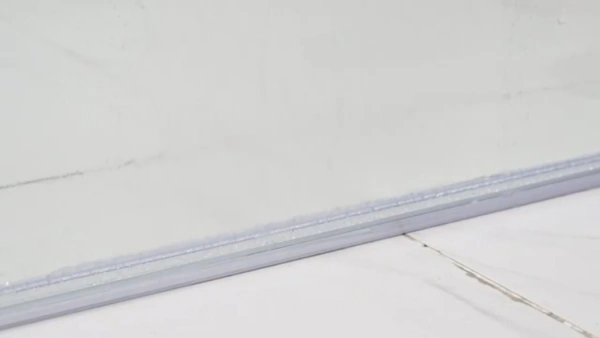
From the above, we can see that there are several factors that can cause shower door seals to discolor over time. But thankfully, there are a few things you can do to keep them from discoloring.
The following tips will help you keep your shower door seals in good shape:
Clean Regularly: Regularly wash your glass shower door seals with mild cleaner and warm water to prevent discoloration and keep them looking their best.
Wipe Down After Use: Wipe down the seals after each use to remove any soap scum, dirt, or other debris that might be present on the surface of the shower seal.
Consider Using a Vinegar-based Cleaner: Vinegar-based cleaners are great for cleaning away tough stains and preventing discoloration as they penetrate deep into the material.
Avoid Harsh Chemicals & Cleaners: Try not to use harsh chemicals or abrasive cleaners when cleaning the shower door seals. They can cause damage to the seal and make it more prone to discoloration.
Seal Preventative Maintenance Measures: Pay attention to how secure your seal is between panels and replace them as necessary. In some cases, the discoloration can result from worn-out seals that don’t fit tightly between panels.
Use a Soft Brush: Clean your shower door seal with a soft brush rather than harsher materials like steel wool, which can scratch and damage the seal over time.
Does Discoloration Mean the Shower Door Sweep Needs to Be Replaced?
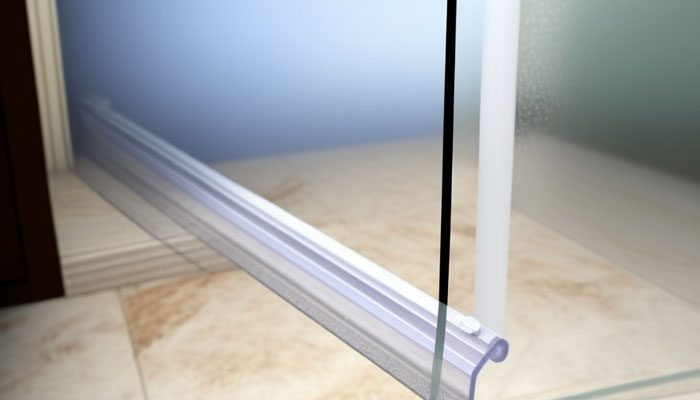
If the discoloration is present on a shower door sweep, it likely indicates that the sweep needs to be replaced. Whenever simple cleaning methods fail to improve the appearance of the sweep, then a new one should be installed as soon as possible.
There are also a few key indicators that it is time to replace your shower door sweep. If you notice water leaking around the seal, if the sweep is torn, cracked, brittle or discolored, it is likely time to be replaced.
You should also check for signs of wear on the rubber gasket or bottom edge of the glass door itself. If you notice any of these signs, it’s best to replace them as soon as possible. Even if you don’t see any damage right away, you should replace the shower door sweep every 1-2 years.
Can Black Mold Stains Be Removed From Shower Seals?
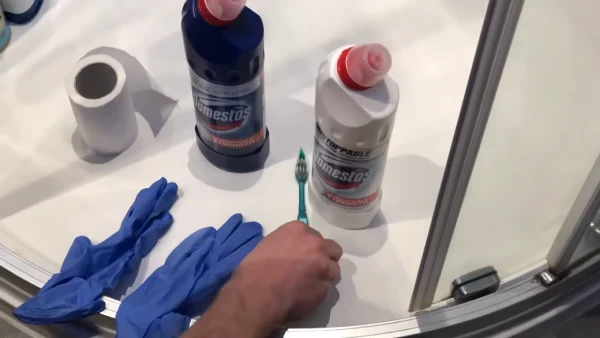
Black mold stains can be removed from shower seals. To remove the stains, use a chlorine bleach solution and wads of toilet tissue. Place the dampened tissue against the stained areas, and transfer the bleach with an old toothbrush for best results.
Dilute the bleach to avoid damaging the sealant material or corroding any metal components with which it may come in contact. Under normal conditions, this process should take no more than 15 minutes.
Be sure to protect yourself and others from the fumes created by using chlorine bleach by wearing a respirator mask if necessary.
Wear protective gloves when handling materials that have been affected by mold, and make sure to dispose of all materials safely after cleaning them. After cleaning, dry up any moisture or condensation around or on the seals to prevent mold spores from growing.
Clean Discoloured Shower Door Seals: Easier than You Think
Dirty shower door seals can be a real nuisance, but with the right cleaning approach and products, you don’t have to face that anymore. Whether your issue is hard water stains buildup or something more complex, you’ll be able to tackle it as long as you have the right arsenal at hand.
You can trust us when we say that taking good care of your seals isn’t just good maintenance, and it’s part of creating a better bathroom experience. Regular cleaning helps brighten and revive the sparkle on those freshly installed seals and guarantees they stay that way for a long time.
So follow our methods, tips, and tricks to keep your bathroom hygienic while ensuring that you get every drop of life out of those sparkly new seals.

